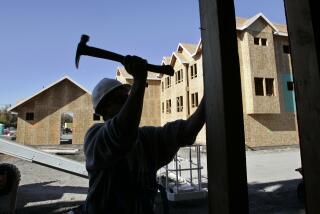How NIMBYs hurt California
If you haven’t heard, another major housing development in Los Angeles has been substantially scaled back as a result of local interest groups and the support they receive from populist politicians. Casden West L.A. was planning to build more than 600 housing units with 160,000 square feet of retail space in West Los Angeles on the new Metro Expo Line. Yet after years of wrangling with various groups, the current plan calls for the retail space to be shrunk by 90% and the number of residences reduced by 7%. Of the residences, more than 10% will have an “affordable” status, meaning other units will be priced commensurately higher to subsidize them.
Maybe this doesn’t sound too draconian, but the outcome of this project is all too familiar. And Los Angeles is suffering for it.
Amazingly, the same people and politicians leading the charge against developers trying to build badly needed homes in the Los Angeles region are also the ones who complain that the highways are too crowded, who rail that their children cannot afford a home in their neighborhood and wonder why some businesses choose to leave for other destinations. These local interests have helped create a housing shortage over the last two decades through pressure tactics that push most growth in the housing stock to the suburban periphery, retail development into a few small dense clusters and drive land prices in the center of cities to levels that are out of reach for most of the population.
And this is true throughout coastal California. Add up the downsized and failed projects, and the net result is a state housing shortage. Seven of the 10 least-affordable housing markets in the nation are in California.
California’s lack of housing is by far the greatest threat to our economic growth. Many businesses cannot hope to compete in national markets when they have to pay workers far more here so those workers can afford a place to live.
What is particularly astounding in the Casden case is that it was a “smart” development — a large project located on one of the light-rail lines that could one day end up being the primary transportation network in a region with an increasingly gridlocked road system. It was proposed to be a mixed-use development, allowing local residents to walk or ride their bikes to shop.
It is no small concern that local NIMBY — “not in my backyard” — groups are consistently able to wield a disproportionate amount of power and threaten even “smart” projects. They delay projects by years and drive up the costs because of legal fees, lobbying and political contributions.
But then, California has honed NIMBYism into a state specialty. Another example is the Il Villaggio Toscano project in Sherman Oaks. First proposed in 2004, the project planned to turn an empty lot on Sepulveda Boulevard into a multi-use complex with 500 residential units and some high-end retail space. In May, the Sherman Oaks Neighborhood Council finally approved it as a 399-unit project — a 20% decrease in the number of housing units. Some members of the council are moving to have it shrunk even more. And these votes are just advisory, as the project ultimately has to be approved by the Planning Commission and the L.A. City Council. The project was almost certainly affected by the financial crisis of recent years, but NIMBY groups also played a major role in the delays and revisions, with home and property owner groups opposing the development citing the usual: noise, traffic, congestion.
The inability to upgrade LAX, the fact that the 710 Freeway doesn’t connect to the 210 Freeway as it was designed to, along with countless other regional planning failures, can be traced to NIMBYism. But with housing, the results are tragic. Los Angeles has some of the most overcrowded housing conditions in the nation, leading to a wide variety of social problems. Still, the very politicians who support NIMBY activities are the same ones who decry high housing costs, blame greedy landlords and developers, and push to pass rules on rent control, affordable housing mandates and other such market distortions.
Want cheaper housing? Highways that aren’t packed with commuters making 30-mile treks? Cleaner air, a more profitable rail system, more businesses moving in and the ability to walk to shopping? The answer is densification — allowing developers to build these type of developments to the fullest extent possible. Do you want to see a system that doesn’t seem to rely on insider influence and political contributions? The answer is simplification — making the process quicker, fairer and transparent.
The solutions are simple.
• Reduce permitting fees and speed up the time it takes to receive them.
• Substantially reform the California Environmental Quality Act, particularly as it relates to residential development, by streamlining the process to make it much faster, less costly and more predictable, and by altering the rules that allow many groups to abuse the process.
• Redo the tax system at the local level, rewarding cities for developing housing rather than retail and office space.
• Create a clear set of zoning rules up front that determine what a developer can or cannot do.
The changes are simple, but the politics of enacting such changes are complex. The first step is for Californians to realize that we are the source of many of the problems that dog our state. And while we may pine for a past of low-density neighborhoods and free-moving highways, growth is inevitable. Working with it, rather than against it, is ultimately the path to the best future.
Christopher Thornberg is an economist and founding partner of a Los Angeles-based economic consulting firm.
More to Read
A cure for the common opinion
Get thought-provoking perspectives with our weekly newsletter.
You may occasionally receive promotional content from the Los Angeles Times.










